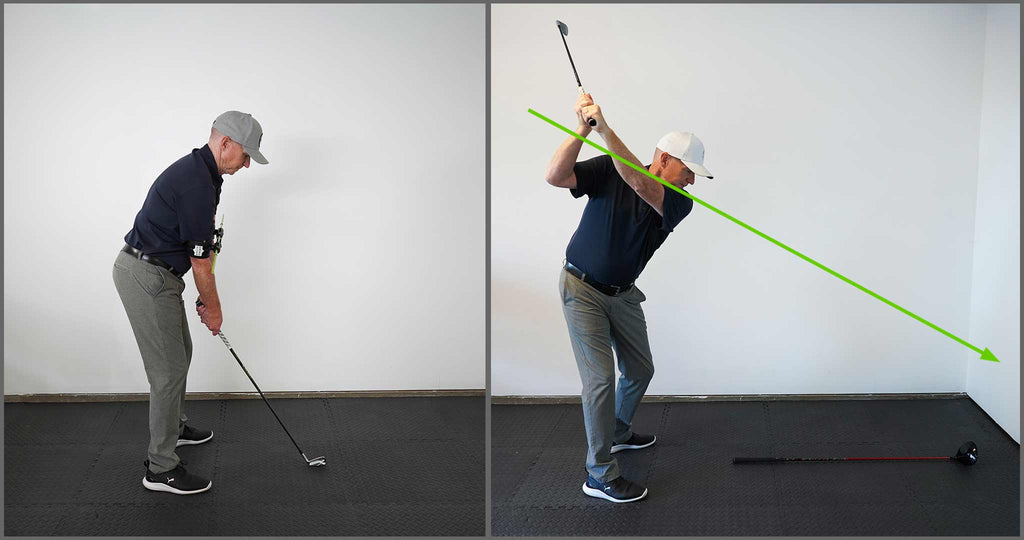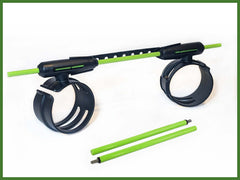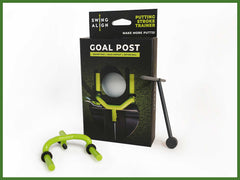Golf Swing Plane Tips
How do you determine the correct golf swing plane for your swing? Golf swing plane has always been one of the most difficult concepts to understand. There have been many books written on the subject, and it still confuses most golfers! The important point to remember is that you should swing on a plane that allows you to deliver the club consistently and repetitively to impact.
In this article we will cover the following:
- What is golf swing plane?
- Why is swing plane important?
- One plane swing
- Two plane swing
- How spine angle affects swing plane
- Swing plane tips
What is Golf Swing Plane?
Simply stated, the golf swing plane is the angle and path your club travels as you swing back from address to the top of your backswing and then back through the ball. Since the length of your arms and the club are fixed your swing has a circular nature to it - in other words all golf swings are circular - and that circular motion occurs along an angled plane because the ball is on the ground next to you.
Golfers typically swing the club on a plane that lies between their shoulders and hips as shown in the below picture of Tiger Woods. A smaller angle with the ground indicates a flatter swing plane typical of a one plane golf swing that moves in the same plane back and through. A larger angle between your swing plane and the ground indicates a steeper swing plane which is typical of a two plane swing where the arms swing up onto a steeper plane at the top.

The golf swing moves both up and around. The less it moves up, and the more it moves around, the flatter your swing plane. If your arms swing around and stay on the same plane as your shoulder tilt at the top then you are a one-planer. The more up you swing on a steeper plane, the less around you swing. If your arms swing up and onto a steeper plane than your shoulders at the top then you are a two-planer. There have been equally great golfers who have employed the two different swings. The most famous one-planer is Ben Hogan. Ernie Els has a classic one plane motion while Tom Watson has a classic two plane swing.
Why is Swing Plane Important?
The below points highlights why finding the right technique and improving your swing plane is so important to becoming a better, more consistent ball striker - the goal of most golfers!
- More consistent shot direction
- Tighter shot dispersion
- More consistent solid contact
- Fewer thin and fat shots
- Fewer dramatic hooks and slices
Both one plane and two plane swings can create power and accuracy. In general, the one plane swing is good for players that have strong flexibility and recoil. A two plane swing is good for players that may not be as flexible but have timing and rhythm. Many top modern golfers have migrated towards one plane swings due to their specialized golf strength and flexibility. Many top instructors advocate for a one plane motion as being able to produce more consistent distance and accuracy.
One Plane Swing
What is a one-plane golf swing? The one-plane swing is flatter and works around your body and your lead arm remains on the same plane as your shoulders at the top. Strong rotation from your shoulders, chest and hips, and maintaining your posture are the keys to a one-plane swing. The set-up for a one plane swing generally has more spine angle with the golfer being bent over around 35 degrees with even weight distribution on each foot. During the backswing your shoulders turn on a steeper angle than your hips because you are bent over more. Your lead arm feels very connected to your chest as your turn back. You rotate your upper body around against the brace of your trail leg, keeping your spine centered, and being sure not to sway.
As the club reaches parallel with the ground on your takeaway the clubface should be square to your spine angle and pointed slightly towards the ground. At the top of the swing your arms should be on the same plane as your shoulders and the angle of your shoulders should be pointed down on a line that runs just past the golf ball. A good drill is to put a driver on the ground outside of the ball and perpendicular to your target line and imagine your shoulders pointing inside the head of the driver. To start the downswing rotate your hips and torso with your arms following in a more passive role. Remember the downswing plane is the same as the backswing plane so just return the club the way you brought it back paying particular attention to keep your spine and shoulders on the same tilted plane. At the finish your trail shoulder has rotated through and is pointed at the target and your arms and hands have rotated around to be above your lead shoulder.

Pros of a One Plane Swing
The positives of a one-plane swing are generally thought to be as follows.
- Simpler and more repeatable
- Fewer moving parts
- Arms and shoulders working together
- Arms and shoulders work on the same plane
Cons of a One Plane Swing
The cons of a one-plane swing are generally thought to be as follows.
- More flexibility is required
- More athleticism is required to stay in your posture
- The ball launches too low for some players
- Some players catch the heel at impact (might need to adjust your club’s lie angle)
Two Plane Swing
What is a two-plane golf swing? The two-plane swing is steeper and characterized by the lead arm swinging up to be more upright than the shoulders at the top of the swing. The set-up for a two plane swing has less spine angle with the golfer generally bent over around 20 degrees with slightly more weight on their back foot. Oftentimes the two plane swing has the ball positioned closer to the body to encourage a more upright turn and the spine tilts back so the shoulders are positioned slightly back of center instead of a more centered set-up in the one plane swing. During the backswing your shoulders turn on a flatter plane closer to the rotation in your hip plane but your arms swing up. The two plane backswing is more timing dependent than the one plane swing because if your shoulders turn too fast your arms can stray to the inside instead and you need to lift them to get to the top.
A couple good thoughts for the two plane swinger are to think about keeping your arms in front of your body as they swing up, and to be sure to rotate your hips to clear some space. You can even lift your front heel to help your turn. All of these things will help compensate for less flexibility. Think back to the driver drill discussed earlier. At the top of a two plane swing your shoulders will not be tilted down as much as in a one plane swing, and they should point out past the head of the driver on the ground. The downswing begins with a slight forward bump of your hips while your shoulders remain passive. This helps your arms separate from the shoulders and drop into the proper plane on the way down. Many players feel like they keep their back to the target for a beat longer to help them drop their arms into a great position before rotating them back to the ball. At the finish the two plane golfer does not rotate their shoulders through as much as the one plane and typically finishes with their chest facing the target.

Pros of a Two Plane Swing
The positives of a two-plane swing are generally thought to be as follows.
- Easier to generate more distance for most golfers
- Don’t need as much flexibility to execute
- More shot variety
- More feel based
Cons of a Two Plane Swing
The negatives of a two-plane swing are generally thought to be as follows.
- Need good timing and tempo to be consistent
- More power but less control for many golfers
- Takes more time to maintain a two plane swing
Spine Angle and Swing Plane
Your spine angle at set-up determines your swing plane. Having more bend in your posture encourages a flatter, one-plane swing while standing taller encourages a more upright two-plane swing. Regardless of what type of swing you choose, you should practice the set-up until it becomes second nature. If you adjust your set-up to help produce a different swing plane it can potentially throw off your alignment, so practicing it becomes that much more important. Maintaining your spine angle throughout your swing is critical, and rehearsing it to develop the muscle memory to execute consistently on the golf course is essential. An important aspect of a proper golf swing plane is maintaining your spine tilt as you rotate, which means your arms and torso need to be strongly connected for a one plane swing, and well synchronized for a two plane swing. Seeking the help of a professional instructor or using a golf plane aid like the Swing Align are great ways to understand and improve your swing plane.
Practice Swing Plane Using Swing Align
Swing Align adds a visual indicator to every part of your golf swing, it allows you to see body positions that you wouldn’t be able to otherwise, and can be a huge help in finding your proper golf swing plane.
An easy check you can do while wearing a Swing Align is to, at the top of your swing, look at the position of the rod across your chest. Ideally you want to see the front end of the alignment rod pointing slightly downward, toward the ground. This indicates that you have maintained the proper spine angle and you are on the proper swing plane.

If the front of the rod is angled up in the air, you have failed to maintain your posture during your backswing which changes your swing plane.

Improve Your Golf Swing Plane with Swing Align!
Swing plane is as important a golf swing fundamental as alignment, connection, or rotation. Swing Align is one of the few truly effective golf swing plane trainers on the market. Check out the full offering of Swing Align products to improve both your full swing and short game fundamentals.
















